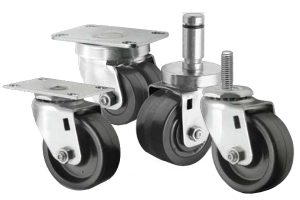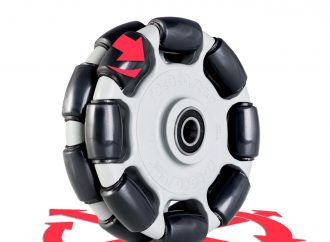Casters are one of those things we take for granted and use every day. From the grocery cart to the office chair you sit in, the caster is a part of moving heavy items easily in multiple directions by pushing or pulling. It has become universal in application regardless of culture. It operates to simple mechanical principles, is easy to produce and use, and is now made in thousands of varieties. There has been a bit of debate about how long casters have been around. Some say they were part of material handling as long ago as Ancient Egypt, others point to the patent applied for by David Fisher in 1876. I would volunteer both are correct. Like a lot of industrial product names and descriptions, the word caster covers a lot of ground. The word caster is not unlike the word Hinge. Both can be used as a noun or a verb depending on context. When we think of a fisherman as a caster, we think of him throwing a line. When we think of an aluminum caster, we could be describing the material of a caster wheel, or an object made of aluminum through the hot metal casting process. Go to Websters dictionary and the word caster in the context of wheels is the third entry!
In its most direct description with respect to the wheel the word caster describes the use of an integrated frame and axle holding a wheel. This “caster” could be made as a separate sub assembly and be attached to a cart or wagon using any one of a few methods. Early casters that were used by the Egyptians were fixed, they did not pivot, turn, or steer.
Steering those casters on a wagon with 4 wheels was complex and expensive. Depending on how sharply you could turn two front wheels determined how much space or “turning radius” it required to change direction. Not a problem when you are driving a Conestoga wagon across a prairie. But a crowded manufacturing plant or hospital meant that space was valuable, and a big turning radius was a problem! Early efforts to make casters pivot consisted of using a post or “kingpin” on top of the caster frame allowing the entire caster frame and wheel to turn. Now there was no reason for that caster to pivot on its own. It was as likely to skip sideways when pulled in a different direction as pivot and roll freely. They worked, but they did not “self-center”.
The caster as we most often understand it today was patented by Mr. Fisher and was driven by advances in materials and the forces of the Industrial Revolution. Many wonder why it took thousands of years to go from the wheel to the self-steering caster of today. The simple fact is that we just did not need them. The caster as we know it is a direct descendant of the industrial revolution and the need to move heavy materials efficiently using the least amount of floor space.
The bit of unique genius Mr. Fisher Patented was the very simple act of offsetting the “kingpin” or “pivot point” of the caster from the axle. Look at the two Illustrations. A fixed caster and then a “self-steering” or “self-centering” caster. The difference is obvious. What this minor adjustment did was revolutionize material handling. The center of the caster frame pivot point, or Kingpin was offset from the center of the axle. By “trailing” the center of the axle behind the pivot point any friction on the side of the wheel (like when pushed in a different direction than it rolls) causes the wheel to pivot and follow the path of least resistance, which is simply to roll in the direction it is pushed. It takes very little space for the turning moment to take place. Space needed to turn a cart without casters can be used for production or treating hospital patients. A cart on four self-steering casters can move in any direction without a steering mechanism and will continue in that direction until some force in another direction is exerted. The caster allows the cart to spin 360 degrees without any travel.
That bit about the friction on the side of the wheel is important. Without it the wheel has no reason to pivot and follow the kingpin or pivot axis. Matching the wheel material to the surface over which it travels is a major part of getting the most out of any caster application. That is why your grocery cart has rubber as the wheel to floor contact. A smooth metal wheel on a smooth floor just does not work as well.
In the time since David Fisher patented the modern self-steering caster it has served humankind in thousands of applications. Today the caster is on your beach cart, your grocery cart, your furniture, and has a role in moving nearly every manufactured good at some point in its life. Every piece of equipment and furniture in a hospital rolls on a smooth riding rubber wheeled caster. It is truly a commodity that is mass produced efficiently and universal in its usefulness.
Even today caster development has continued. New styles of casters known “Roto-casters” or Omni-Directional casters have rollers installed around the perimeter of the caster wheel. This eliminates the need for trailing the pivot point from the axle to get a caster to self-center to force in different directions. The wheel need not pivot at all.
The caster is one of those simple devices that is truly genius in its principal of operation. While the modern caster was patented just 150 years ago, it is part of the everyday life of most everyone on the planet.


